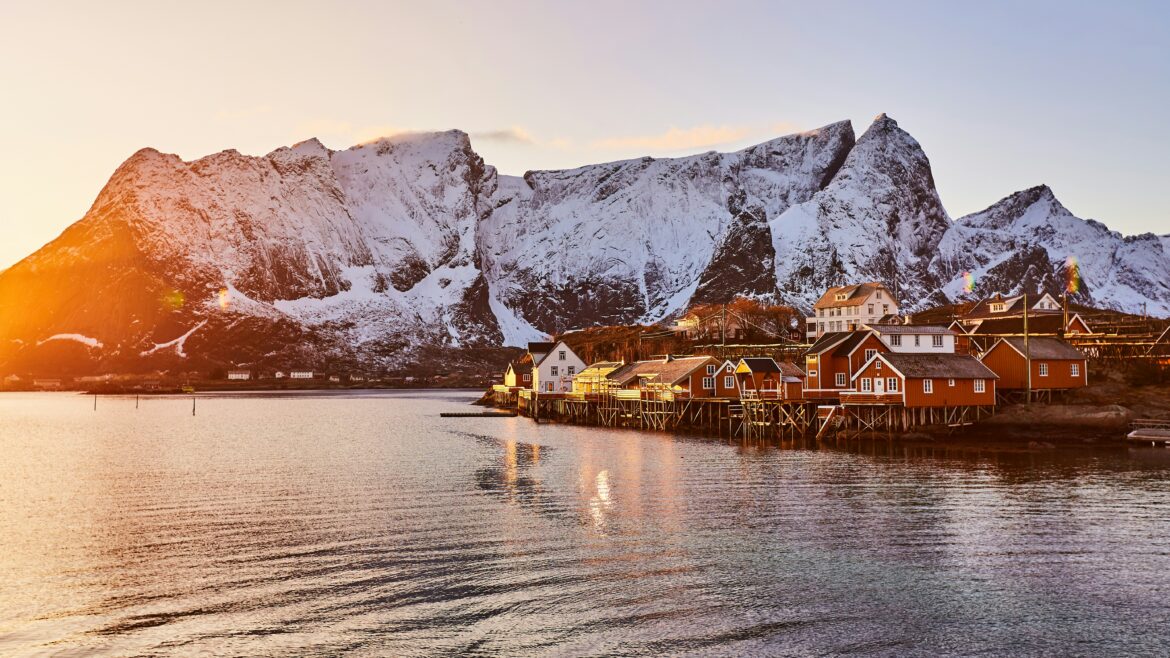For many, the idea of traveling north of the Arctic Circle in winter isn’t appealing. But step into Norway’s Arctic and you’ll find a landscape that feels straight out of a snow globe—crisp air, vast skies, jagged mountains, and colorful fishing villages dusted with snow.
Tromsø andthe Lofoten Islands, a rugged chain of peaks and fjords stretching into the Norwegian Sea, are at the heart of this frosty wonderland. The Lofoten archipelago has graced the pages of many glossy travel magazines and is one of the most memorable places to experience an Arctic winter, whether you’re chasing auroras, braving the chill, or sipping coffee in a cozy cabin.
Arriving in the Arctic Circle
Most Arctic adventures begin in Tromsø. Easily reached by domestic flights from Oslo, this small but lively city offers your first taste of polar life. Expect wooden houses painted in cheerful colors, snow-covered landscapes, and tempting cafés.
Tromsø is also one of the best places in the world to see the aurora borealis, thanks to its location under the “aurora oval”—a belt of frequent northern lights activity. Join a guided tour or simply head out of town with a rented car and a thermos of hot chocolate.
While exploring the city’s cozy cafés, galleries, and waterfront, it’s a good idea to pack insulated snow boots and a pair of ice cleats – the pavements can get slippery underfoot, especially after a fresh dusting of snow or during freeze-thaw spells.
- Tromsø Ice Domes
For a truly magical Arctic experience, consider a visit to the Tromsø Ice Domes, located in the sereneTamok Valley, about 95 km from Tromsø. Rebuilt each winter by ice artists, the domes feature intricately carved snow and ice sculptures, themed rooms, and even an ice bar and cinema.
- Snorkeling with Orcas
If you’re up for an adventure that’s truly out of the ordinary, winter in Tromsø also offers the chance to snorkel with orcas. From late October to mid-January, large pods of orcas and humpback whales gather in the nearby fjords to feed on herring.
The Sula liveaboard and land-based operators run snorkeling tours that allow you to watch these magnificent creatures up close in the wild. It is very cold in the water (bring Merino base layers to wear under the dry suit provided), but seeing an orca glide by, just meters away, is an unforgettable experience!
- Lofoten Islands
A day-long drive, ferry, or bus brings you to the stunning Lofoten Islands. The scenery here is spectacular. Think dramatic peaks rising straight out of the sea, vibrant red fishermen’s cabins along the shorelines, and fjords that slice deep into the landscape.
In winter, the islands sometimes get dusted with snow, but the Gulf Stream keeps temperatures surprisingly mild for the Arctic. What sets Lofoten apart is the sense of peaceful wildness and exploration – you might go hours without seeing another car, just moose and the occasional white-tailed eagle.
Make sure you take time to visit the remote village of Å, one of the most secluded and picturesque villages in the Lofoten Islands.
- Northern Lights & Polar Nights

The days are very short during the Arctic winter, but don’t let that put you off. From November to January, the sun doesn’t rise fully above the horizon, casting the landscape in a dreamy bluish-pink twilight known as the polar night. It’s a surreal, beautiful time to visit, with soft light all day and a better chance of seeing the northern lights on clear nights.
In Lofoten, the best viewing often happens around Unstad, Eggum, or Gimsøy. Dress warmly, bring a tripod and spare camera batteries, and be patient—the aurora often shows up when you’re about to give up.
- Saunas & Sea Dips
There’s something deeply satisfying about embracing the cold, and Norwegians have perfected the art. Many accommodations offer saunas, and a few brave souls take it a step further, plunging into cold waters between sauna rounds.
You can also try snowshoeing and winter kayaking. And yes, for those curious and adventurous, scuba diving in Lofoten is possible—dry suits and all. It’s not for the faint of heart, but the visibility is excellent, and in some areas, you can dive among kelp forests and cold-water marine life.
- Local Flavors & Arctic Comfort Food
Norwegian Arctic cuisine is all about warming, hearty food made with what the land (and sea) provides. Stockfish (air-dried cod) is a Lofoten staple, exported for centuries and still hung on wooden racks to dry. You’ll also find rich fish soups, reindeer stews, and cinnamon-sugar buns in nearly every café, including at the Lofoten’s most famous bakery – the bakery at Å.
Restaurants in towns like Svolvær and Leknes serve elegant twists on traditional dishes, using Arctic char, local lamb, and ingredients like sea buckthorn and juniper.
- Slow Days and Cozy Nights
One of the best parts of traveling in Arctic Norway in winter is the pace. Days are slow and unhurried, and nights are made for curling up with a book or chatting by the fire while snow falls outside.
Whether you’re staying in a restored fishing cabin or a modern Arctic lodge, the warmth of the indoors is as much a part of the experience as the wildness outside. Bring layers, slippers, and a sense of wonder.
When to Go
The best time to visit Tromsø and the Lofoten Islands for an Arctic winter experience is between November and March. Here’s what to expect:
- November-January: Polar night season. No sunrise, but beautiful twilight light and good chances of seeing the northern lights.
- March-April: More snow for winter activities, the highest level of aurora activity.
- April: Warmer days as spring approaches, the most likely month for snow in Lofoten.
This article was written by Kathryn Curzon, a shark conservationist and dive travel writer for SSI.

Leave a Reply